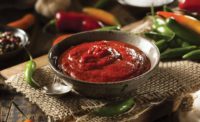Passport to Flavor
Peppers are an effective way to add various heat and flavor attributes to Hispanic dishes—from meats and mains, to soups and sides.

Use of peppers and chiles (like Hatch chiles, pictured) has increased on all menus and across several cuisines.
PHOTO COURTESY OF MIZKAN AMERICA INC.

Some of the most popular fresh chiles on menus include jalapeno, serrano, habanero, poblano and New Mexico chiles (both red and green).
PHOTO COURTESY OF MIZKAN AMERICA INC.


Spicy, bold and exotic international flavors continue as powerhouse trends for manufacturers and food and beverage retail sales. According to the latest Mintel International Foods Summary1, retail sales of international foods reached $10 billion in 2016, up 3.4% over 2015. Perhaps not surprisingly, Mintel found that Mexican/Latin foods accounted for 60% of those sales.
US consumers are seeking hot and spicy flavor combinations, followed closely by savory. Menus and flavors are much more sophisticated than they have been in the past and the combinations of fresh, pickled, roasted and charred really lend themselves to these profiles. Use of chiles and peppers specifically has increased on all menus and across several cuisines. With Americans welcoming heat to their palates, manufacturers can adapt more Hispanic and Latin flavors in their formulations.
Peppers and Chiles Create Heat
Red jalapenos and smaller regional peppers like aji amarillo and chile pequin are making their way onto menus in addition to peppers, including fire-roasted poblano and dried guajillo. Consumers are showing a willingness to experiment with newer regional Latin flavors from Peru and Colombia. Some great uses for these include sauces, salsas and marinades.
“Our customers are consistently looking for authentic Latin flavors and products specific to their culture,” notes Executive Chef Fernando Desa at Goya Foods.
He says his experience shows that Mexican and South American flavors tend to favor hot and spicy flavors, while other Latin regions seek a more savory taste. According to Desa, consumers are more open to new ingredients from other countries and they are eager for new spices, recipes, and ingredients from Latin cultures.
Also speaking out is Chef Christopher Hansen, corporate executive chef with the OSI Group.
“A variety of chiles add flavor and heat in many entrée items,” he says. “Some of the most popular fresh chiles on menus include jalapeno, serrano, habanero, poblano and New Mexico chiles (both red and green).”
He notes that milder Anaheim chiles and dried chiles, including guajillo, pasilla, ancho, morita and cascabel are showing up on menus.
Population Mix Drives Complexity
Pew Research2 shows that the while Latinos account for 57 million people in the US and for half of the overall population growth in the country, the growth has gradually been slowing and is expected to level off by 2021.
The vibrant mix of people from Mexico, Puerto Rico, Cuba, El Salvador, Guatemala, Columbia and others influences the desire for authentic flavors and easily makes Latin foods a flavor leader. A whopping 83% of consumers have eaten Mexican cuisine in the past three months.1
Chef Desa likes to use “Latin fusion” to appeal across several cultures.
He observes, “While many Hispanics often keep true to the food they ate in their homeland, Latin cultures are blending and morphing here in the US, so I love to create Latin fusion recipes that cater to many tastes.”
Main Courses and Comfort Go Hand in Hand
Nostalgia for flavors of home has led to a proliferation of Hispanic comfort foods on menus. Sweet and heat profiles with heat from peppers balanced by honey, brown sugar or molasses, tend to work well with main courses.
Chef Hansen says slow-cooked meats are a stand-out in Hispanic comfort foods.
“Meats are so versatile and pair really well with red and green jalapenos and other peppers,” he says. “Pork, including the tender, marinated al pastor, the slow-roasted cochinita pibil and the highly seasoned sausage chorizo, are becoming more familiar to a wider population. Even chicharrón, or pork rinds, are being used to add flavor and crunchy texture to dishes.”
Bold Flavors and At-Home Experience on the Rise
While the Mintel report indicates that consumers try international cuisine at restaurants 60% of the time versus 40% at-home meals, the proliferation of good-tasting, healthy and easy-to-make dishes is boosting at-home experimentation.
Consumers are intrigued with cuisine posts on social media, including Pinterest, that have Latin influence and they are eager to try recipes at home. Desa adds that cooking shows food bloggers provide easy access to online recipes and demonstrations, which help consumers try new spices and recipes from other cultures—especially Latin cultures.
Peppers are an effective way to add various heat and flavor attributes to Hispanic dishes—from meats and mains, to soups and sides. Whether it is hot/spicy, savory or heat/sweet combination, there are limitless combinations to explore as consumers stamp their food “passports.” Trends from fine-dining continue to influence manufacturing and the variety in formulations and ideations for Hispanic cuisine are seemingly endless.
1Mintel International Food Trends, March 2017
2Pew Research Center Analysis of U.S. Hispanic Population, August 2017
Juliet Greene is corporate chef at Mizkan America, Inc. Dave Sackett is the company’s executive director of sales and marketing.
For more information:
Mizkan America, Inc.
1661 Feehanville Dr., Suite 300
Mt. Prospect, IL 60056
Dave.sackett@mizkan.com
Looking for a reprint of this article?
From high-res PDFs to custom plaques, order your copy today!







